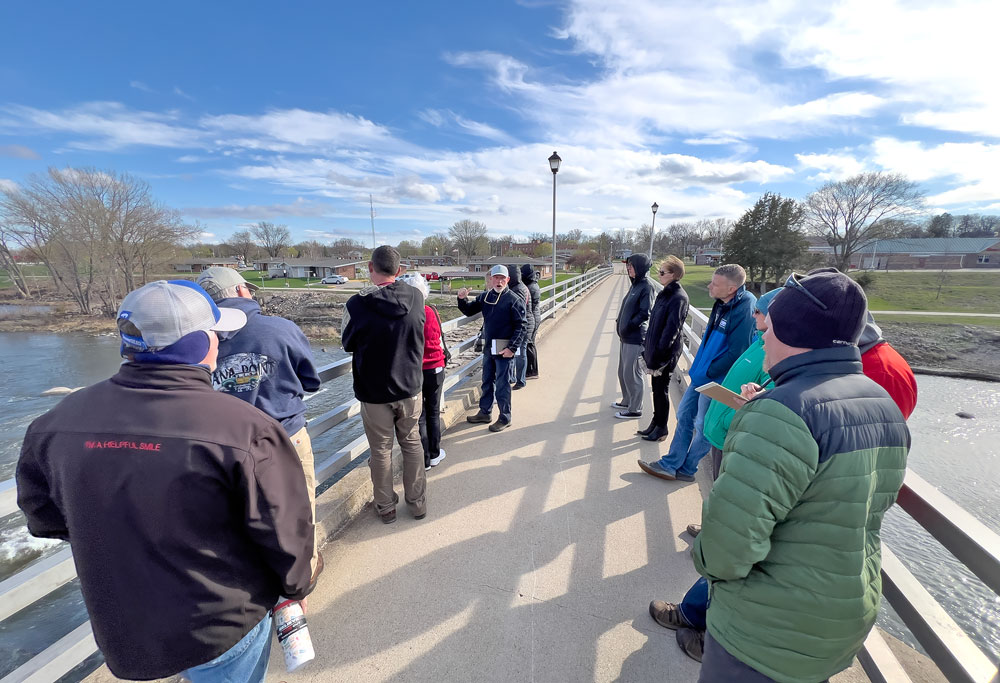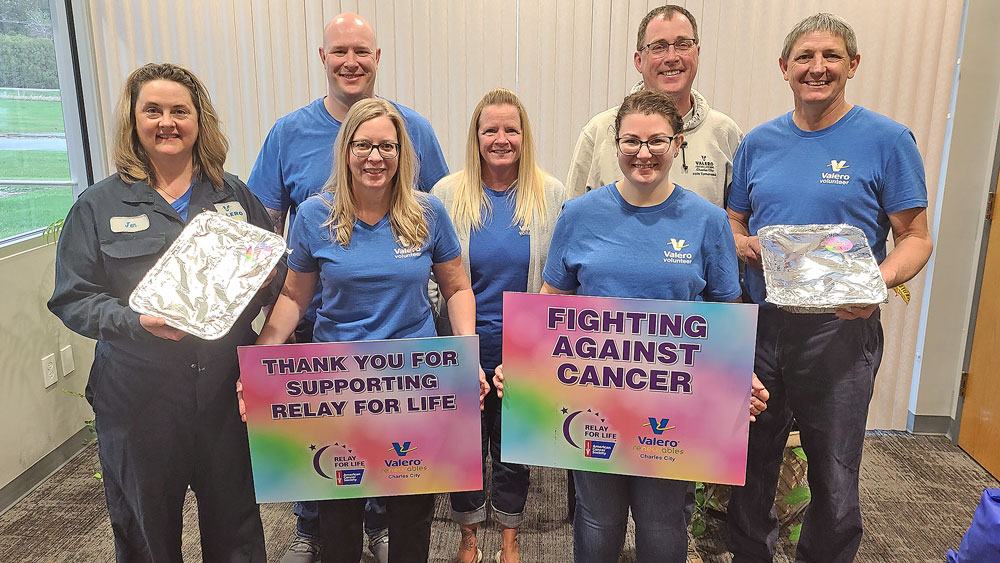Floyd County property owners question impact of proposed CO2 pipeline project

By Bob Steenson, bsteenson@charlescitypress.com
More than 100 people gathered at the Floyd Community Center Monday evening to hear about a proposed carbon dioxide pipeline running through Floyd County — and potentially through their properties.
The meeting, held by the Iowa Utilities Board, was the first opportunity for Summit Carbon Solutions to present details of its planned $4.5 billion, 2,000-mile, five-state pipeline network to Floyd County landowners who are in its path.
Josh Byrnes, a former area legislator from Osage who is now a member of the Iowa Utilities Board, started off the meeting explaining some of the legal process that Summit Carbon will need to go through in Iowa.
It includes holding meetings similar to Monday night’s gathering in each of the 30 counties that the project will impact in the state. The Floyd County meeting was the eighth meeting the Iowa Utilities Board and Summit Carbon Solutions have held, beginning with Hardin County a week earlier.
The last in-person meeting is scheduled for Oct. 15 in Webster County, and there will also be an online virtual meeting held Tuesday, Oct. 12. Thirty days after the final meeting, Summit Carbon can apply for a permit for construction and operation, then there will an evidentiary hearing and an official opportunity for people to provide input, Byrnes said.
Comments on the project can be submitted now, but must be in writing to be considered, and are preferred by being entered at the Utilities Board’s electronic filing website, efs.iowa.gov.
The company’s goal is to begin construction in 2023 and begin operations in 2024, but it has a long process ahead of it to apply for and receive a permit from the Iowa Utilities Board, Byrnes said.
And that’s just for Iowa. The company will need to go through each of the five states’ processes for permission to build and operate, do environmental and cultural impact studies, deal with local governments for access under public roads, as well as receiving a variety of federal permits and permissions and even dealing with dozens of Native American nations.
“One of my responsibilities tonight is to verify that Summit Carbon has met all statutory and administrative rule requirements” for the Floyd County informational meeting, Byrnes said Monday. “At the end of tonight’s presentations, I will make the declaration as to whether or not Summit Carbon has complied with Iowa law.”
Under the Iowa permitting process for a hazardous liquid pipeline, as the carbon dioxide pipeline would be categorized, Summit Carbon couldn’t negotiate with landowners about potential easements until after the meeting in those landowners’ county is held.
SEEKS 100-FOOT TEMPORARY, 50-FOOT PERMANENT EASEMENTS
The company will be seeking 100-foot-wide temporary construction easements and 50-foot-wide permanent easements for the pipeline.
At the end of the meeting Monday, Byrnes said he was certifying that Summit Carbon had met the meeting requirements and easement negotiations could begin in Floyd County.
About the first half of the almost-two-hour meeting Monday was spent with Byrnes discussing the permitting process and the legal rights of landowners, and by three representatives of Summit Carbon explaining the scope of the project and how landowners will be compensated for easements to their property.
The second half of the meeting was spent answering questions asked by people in the audience. Based on the questions, many of them were skeptical about how property owners would be treated.
The Summit Carbon representatives said they would pay market value for the 50-foot strip of land required for a permanent easement along the pipeline’s route — paying the landowner as much for access to the land as if they were purchasing it, while still letting the landowner own and use the land.
One questioner said a 50-foot strip through the length of his property would equal about 5 acres, and asked, if land prices were $10,000 an acre, if that meant he would be paid that much per acre for the easement.
The answer was yes, said Jake Ketzner, a Summit Carbon vice president. And the farmer would still have full use of that land for crops or other uses, subject to some limitations such as not building a structure over it.
“And we’d rather you not plant trees on it,” he said.
Byrnes confirmed that granting an easement did not transfer ownership or title to the land, but did grant access when needed.
QUESTIONS ABOUT SAFETY
Once the pipeline was constructed and the land restored to the way it was before construction, most landowners would never have anything to do with Summit Carbon unless there was an emergency — and the company was going beyond the legal safety requirements to make sure that didn’t happen, said Jimmy Powell, Summit Carbon chief operating officer.
But the potential of an emergency or other danger was the topic of several questions.
Carbon dioxide is neither flammable nor combustible, a company representative emphasized. In fact, firefighters use it to put out fires, he said.
But it is what’s known as a simple asphyxiant, meaning that although it isn’t toxic it can deprive the body of needed oxygen if you’re breathing too much of it.
The company said it would work with local fire departments and other emergency departments to make sure they were prepared to help Summit Carbon respond to any leaks, but said the only time a leak was likely to occur was if someone was digging without first checking for buried lines and struck the pipe.
The top of the pipeline would be buried a minimum of four feet underground.
Some questions concerned the pressure in the pipeline as the gas is compressed into a liquid.
A Summit Carbon representative said the pressure would be about 2,100 pounds per square inch, and the steel pipe was designed for and would be tested for much higher pressures than that, he said. All the welds would be X-rayed, he added, not just the sampling required by law.
And all the steel used would come from American companies, a representative said in response to another question. The company was committed to using American-made products, unless some needed piece was not available made in this country.
The Summit Carbon representatives emphasized that this was a project originating in Iowa, and the pipeline monitoring and control center would be in Ames. All three of the representatives at the meeting Monday had lived in Iowa for much of their adult lives, they said.
EMINENT DOMAIN AND CONDEMNATION COULD BE USED
The Summit Carbon representatives said over and over again that their goal was to get the property easements voluntarily through negotiations with landowners, and they would work with the property owners to come to acceptable terms.
What they declined to acknowledge, even when pressed by people asking questions, was that if agreements couldn’t be reached with some landowners the possibility of condemnation proceedings through eminent domain would be on the table.
Byrnes said the Iowa Utilities Board would determine if the project qualifies for eminent domain status if it is requested, but even if it did, local county condemnation compensation boards would determine what property owners would receive for forced easements.
As part of the compensation for easements, Summit Carbon Solutions will pay landowners 100% of the value of their cropland yield on the easement land for the first year, 80% for a second year and 60% a third year.
They’ll get that money upfront, regardless of whether there’s actually an impact to yields, said Jesse Harris, one of the Summit Carbon representatives. If they happened to have harvested that year’s crop by the time construction starts, they’ll still get the payment.
And the company is required by law to return the ground to the same condition as it was before construction, with independent inspectors in each county monitoring to make sure that happens.
A questioner asked what the crop price would be based on for that compensation.
“You decide,” said Powell, adding that any generally accepted, published commodity price could be used.
They also said that if the company did need to access the property for some reason in the future after construction had taken place, they would again return the ground to its original condition and compensate the landowners for any damages.
SCOPE OF THE PROJECT
The project’s intent is to capture carbon dioxide emissions from ethanol and other manufacturers in Iowa, Minnesota, Nebraska, South Dakota and North Dakota, compress it into a liquid and transport it in an underground pipeline network to an area northwest of Bismarck, North Dakota.
There, it would be injected into geological voids a mile underground and remain “for millions of years,” a Summit Carbon representative said Monday.
Harris said there have been many studies confirming the potential and the safety of carbon storage in that area.
Summit Carbon Solutions plans to store 12 million metric tons of carbon a year in the underground area, but the area has the capacity to store 250 billion tons — enough to store the entire carbon output of the country for 50 years, Harris said.
Although proponents of this and other carbon capture and storage technologies tout the environmental benefits of keeping all that carbon dioxide out of the atmosphere, the Summit Carbon representatives Monday said one of their main goals is to keep ethanol production viable for decades to come.
That’s especially important to farmers in Iowa, where 44% of the corn crop each year currently goes to ethanol production, they said. So far, 31 ethanol plants, including 12 in Iowa, have signed on to the project, representing 75% of the pipeline’s capacity.
And they emphasized the additional economic impacts of the project, creating about 15,000 construction jobs for a year or two, then 350 to 460 permanent jobs to monitor and maintain the pipeline.
Summit Carbon Solutions is part of Iowan Bruce Rastetter’s Summit Agricultural Group, a major player in the ethanol industry.
INCOME WOULD COME FROM ETHANOL PLANTS AND TAX CREDITS
About a fourth of Summit Carbon Solutions’ revenue would come from a $50 per metric ton tax credit the federal government has in place for capturing and storing carbon, a company representative said. But three-fourths of the revenue for the pipeline would come from ethanol plants, which would use the carbon storage to reduce their carbon intensity score and make it easier to market their product.
Enough carbon will be captured and stored to make the participating ethanol plants carbon neutral or even carbon negative — better than electric cars, a representative said.
The Summit Carbon Solutions pipeline would be the largest carbon capture and storage project in the world, the company representatives said, but it would take hundreds of such projects to meet the carbon emission reduction goals for the country, he added.
Another carbon dioxide pipeline project has also been proposed to go through Iowa and Floyd County. Heartland Greenway System is a proposal by Navigator Energy Services of Dallas, Texas. It would include carbon-dioxide-emitting industries in Iowa, Minnesota, South Dakota, Nebraska and Illinois, and pipe the liquid carbon dioxide to underground storage in central Illinois.
No public meetings have been set yet on the Heartland Greenway project.
Valero Energy Corp. has signed on as an anchor company for the Navigator project, with eight ethanol plants in the five states.
Current ethanol plant partners with Summit Carbon Solutions are:
Iowa Ethanol Plants:
- Corn LP, Goldfield
- Golden Grain Energy, Mason City
- Green Plains, Shenandoah
- Green Plains, Superior
- Homeland Energy Solutions, Lawler
- Lincolnway Energy, Nevada
- Little Sioux Corn Processors, Marcus
- Louis Dreyfus, Grand Junction
- Pine Lake Corn Processors, Steamboat Rock
- Plymouth Energy, Merrill
- Quad County Corn Processors, Galva
- Siouxland Energy Cooperative, Sioux Center
Nebraska Ethanol Plants
- Green Plains, Atkinson
- Green Plains, Central City
- Green Plains, Wood River
- Green Plains, York
- Husker Ag
- Louis Dreyfus, Norfolk
North Dakota Ethanol Plant
- Tharaldson Ethanol
Minnesota Ethanol Plants
- Granite Falls Energy
- Green Plains, Fairmont
- Green Plains, Fergus Falls
- Heron Lake Bioenergy
- Highwater Ethanol
South Dakota Ethanol Plants
- Dakota Ethanol
- Glacial Lakes Energy, Aberdeen
- Glacial Lakes Energy, Huron
- Glacial Lakes Energy, Mina
- Glacial Lakes Energy, Watertown
- Redfield Energy
- Ringneck Energy







Social Share